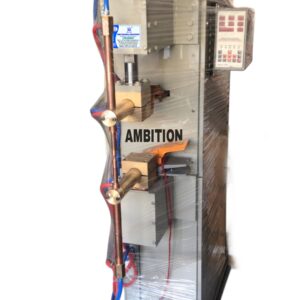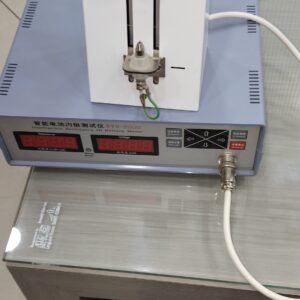| Catalog | ➢ The weld is possible without using any filler or flux material. |
|---|
₹73,000.00 ₹62,000.00
Spot welding basically joins two pieces of metal using the heat from an electric current. The two pieces of metal are pressed together with electrodes on either side. The electrodes are connected via a small spot. The current must be applied for the correct amount of time in order to get a strong join. The exact timing will depend on the types and thickness of metals being joined.
| Model: | UNIT | JSP-10P | JSP-15P | JSP-20P | JSP-25P | JSP-30P | JSP-40P |
| Rating @ 50% Duty Cycle | KVA | 10 | 15 | 20 | 25 | 30 | 40 |
| Input Supply | V | 220/415 | 220/415 | 380 / 440 | 380 / 440 | 380 / 440 | 380 / 440 |
| Frequency | HZ | 50/60 | 50/60 | 50/60 | 50/60 | 50/60 | 50/60 |
| Controlling System | Type | Electronic Timer | Electronic Timer | Electronic Timer | Electronic Timer | Electronic Timer | Electronic Timer |
| Phase | Rating | 2 Lines of 3 Phase | 2 Lines of 3 Phase | 2 Lines of 3 Phase | 2 Lines of 3 Phase | 2 Lines of 3 Phase | 2 Lines of 3 Phase |
| Throat Depth | mm | 460 | 460 | 460 | 460 | 460 | 460 |
| Nominal Throat Clearance | mm | 220 | 220 | 220 | 220 | 220 | 220 |
| Brass rod Length | inch | 16 | 18 | 18 | 18 | 18 | 18 |
| Brass rod | mm | 400 | 450 | 450 | 450 | 450 | 450 |
| Brass Rod Daimeter | mm | 45 | 45 | 50 | 50 | 50 | 50 |
| Weld Material type | grade | M.s, S.s, G.i , C.r.c, Brass Etc., | M.s, S.s, G.i, C.r.c, Brass Etc., | M.s, S.s, G.i, C.r.c, Brass Etc., | M.s, S.s, G.i, C.r.c, Brass Etc., | M.s, S.s, G.i, C.r.c, Brass Etc., | M.s, S.s, G.i, C.r.c, Brass Etc., |
| Copper anode | mm*inch | 16mm * 10inch | 19mm * 10inch | 22 mm * 10 inch | 22 mm * 10 inch | 22 mm * 10 inch | 22 mm * 10 inch |
| Suitable For Welding Rod | mm | 4 + 4 | 5 + 5 | 6 + 6 | 6.8 + 6.8 | 8 + 8 | 8.5 + 8.5 |
| Suitable For Welding Sheet | mm | 1.6 + 1.6 | 2 + 2 | 3.25 + 3.25 | 3.5 + 3.5 | 3.75 + 3.75 | 4 + 4 |
| Suitable For Welding Sheet | swg | 16 gauge | 14 gauge | 10 gauge | 8 gauge | 8 gauge | 8 gauge |
| Max. available short circuit currents | KA | 6 | 8 | 9 | 11 | 12 | 14 |
| Insulation Class: | F | F | F | F | F | F | |
| Nominal Electrode Force – Approx. | kgf | 100 – 75 | 100 | 100 | 110 | 110 | 125 |
| Electrode Stroke Max. | mm | 40 | 40 | 40 | 40 | 40 | 40 |
| Cooling for Transformer /(Arms Electrods) | Air/Water | Air/Water | Air/Water | Air/Water | Air/Water | Air/Water | |
| Automation Grade | Pneumatic | Pneumatic | Pneumatic | Pneumatic | Pneumatic | Pneumatic | |
| Water at max. temperature of 30°C | Liters/min | 3 | 3 | 3.5 | 3.5 | 3.5 | 4 |
Related products
-
Sale!
 Add to Quote
Add to QuoteSpot welding basically joins two pieces of metal using the heat from an electric current. The two pieces of metal are pressed together with electrodes on either side. The electrodes are connected via a small spot. The current must be applied for the correct amount of time in order to get a strong join. The exact timing will depend on the types and thickness of metals being joined.
Workpiece preparation: Projections are created on the workpiece. This can be done by embossing, machining, or stamping.
Placement: The workpieces are placed between large, flat, water-cooled copper electrodes. Unlike spot welding, the electrodes in projection welding are flat and do not concentrate the current.
Pressure application: A large amount of force is applied to the electrodes, which transfers the pressure to the workpieces, concentrating it at the raised projections.
Current flow: A high-amperage current is passed through the electrodes and into the workpieces. Because the contact points are small, the electrical resistance at the projections is high, generating a concentrated heat.
Fusion: The heat causes the projections to melt and collapse, fusing with the mating part to form a strong weld nugget.
Cooling and forging: The pressure from the electrodes is maintained until the weld nugget solidifies, effectively forging the joint. -
Sale!
 Add to Quote
Add to QuoteAmbition weld Industries Manufacture High Quality Lithium Battery spot welding Machine for the uses a short cycle, high-current pulse to join nickel strips to Cell terminals. A very short but intense electrical current (usually 2–10 milliseconds) is sent through the electrodes and into the nickel strips. You can choose a spot welder based on your project’s needs Like
1. Portable Type 3 Kw
2. Portable Industrial Type 4 KW
3. Manual TAble Type 6KW
4. Pneumatic Table Type 6 KW
5. Pneumatic Free Size 8 KW -
Sale!
 Add to Quote
Add to QuoteSpot welding basically joins two pieces of metal using the heat from an electric current. The two pieces of metal are pressed together with electrodes on either side. The electrodes are connected via a small spot. The current must be applied for the correct amount of time in order to get a strong join. The exact timing will depend on the types and thickness of metals being joined.



